 W
WAstrophysical plasma is plasma outside of the Solar System. It is studied as part of astrophysics and is commonly observed in space. The accepted view of scientists is that much of the baryonic matter in the universe exists in this state.
 W
WAn aurora, sometimes referred to as polar lights, northern lights, or southern lights, is a natural light display in the Earth's sky, predominantly seen in high-latitude regions.
 W
WCoronal loops are huge loops of magnetic field beginning and ending on the Sun's visible surface (photosphere) projecting into the solar atmosphere (corona). Hot glowing ionized gas (plasma) trapped in the loops makes them visible. Coronal loops range widely in size up to several thousand kilometers long. They are transient features of the solar surface, forming and dissipating over periods of seconds to days. They form the basic structure of the lower corona and transition region of the Sun. These highly structured loops are a direct consequence of the twisted solar magnetic flux within the solar body. Coronal loops are associated with sunspots; the two "footpoints" where the loop passes through the sun's surface are often sunspots. This is because sunspots occur at regions of high magnetic field. The high magnetic field where the loop passes through the surface forms a barrier to convection currents, which bring hot plasma from the interior to the sun's surface, so the plasma in these high field regions is cooler than the rest of the sun's surface, appearing as a dark spot when viewed against the rest of the photosphere. The population of coronal loops varies with the 11 year solar cycle, which also influences the number of sunspots.
 W
WEnergetic neutral atom (ENA) imaging, often described as "seeing with atoms", is a technology used to create global images of otherwise invisible phenomena in the magnetospheres of planets and throughout the heliosphere, even to its outer boundary. This constitutes the far-flung edge of the solar system.
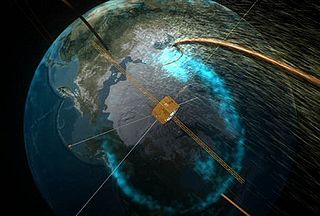 W
WA flux transfer event (FTE) occurs when a magnetic portal opens in the Earth's magnetosphere through which high-energy particles flow from the Sun. This connection, while previously thought to be permanent, has been found to be brief and very dynamic. The European Space Agency's four Cluster spacecraft and NASA's five THEMIS probes have flown through and surrounded these FTEs, measuring their dimensions and identifying the particles that are transferred between the magnetic fields.
 W
WHeliophysics is an aspect of NASA science that enables understanding the Sun, heliosphere, and planetary environments as a single connected system. In addition to solar processes, this domain of study includes the interaction of solar plasma and solar radiation with Earth, the other planets, and the galaxy. By analyzing the connections between the Sun, solar wind, and planetary space environments, the fundamental physical processes that occur throughout the universe are uncovered. Understanding the connections between the Sun and its planets will allow for predicting the impacts of solar interaction on humans, technological systems, and even the presence of life itself. This is also the stated goal of Science Mission Directorate's Heliophysics Research.
 W
WThe Heliophysics Science Division of the Goddard Space Flight Center (NASA) conducts research on the Sun, its extended solar system environment, and interactions of Earth, other planets, small bodies, and interstellar gas with the heliosphere. Division research also encompasses geospace—Earth's uppermost atmosphere, the ionosphere, and the magnetosphere—and the changing environmental conditions throughout the coupled heliosphere.
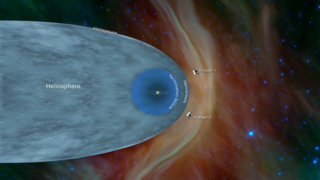 W
WThe heliosphere is the vast, bubble-like region of space that surrounds and is created by the Sun. In plasma physics terms, it is the cavity formed by the Sun in the surrounding interstellar medium. The "bubble" of the heliosphere is continuously "inflated" by plasma originating from the Sun, known as the solar wind. Outside the heliosphere, this solar plasma gives way to the interstellar plasma permeating the Milky Way. Radiation levels inside and outside the heliosphere differ; in particular, the galactic cosmic rays are less abundant inside the heliosphere, so that the planets inside are partly shielded from their impact. The word "heliosphere" is said to have been coined by Alexander J. Dessler, who is credited with first use of the word in scientific literature in 1967. The scientific study of the heliosphere is heliophysics, which includes space weather and space climate.
 W
WThe heliospheric current sheet is the surface in the Solar System where the polarity of the Sun's magnetic field changes from north to south. This field extends throughout the Sun's equatorial plane in the heliosphere. The shape of the current sheet results from the influence of the Sun's rotating magnetic field on the plasma in the interplanetary medium. A small electrical current flows within the sheet, about 10−10 A/m2. The thickness of the current sheet is about 10,000 km near the orbit of the Earth.
 W
WThe interplanetary medium (IPM) consists of the mass and energy which fills the Solar System, and through which all the larger Solar System bodies, such as planets, dwarf planets, asteroids, and comets, move. The IPM stops at the heliopause, outside of which the interstellar medium begins. Before 1950, interplanetary space was widely considered to either be an empty vacuum, or consisting of "aether".
 W
WLightning is a naturally occurring electrostatic discharge during which two electrically charged regions in the atmosphere or ground temporarily equalize themselves, causing the instantaneous release of as much as one gigajoule of energy. This discharge may produce a wide range of electromagnetic radiation, from very hot plasma created by the rapid movement of electrons to brilliant flashes of visible light in the form of black-body radiation. Lightning causes thunder, a sound from the shock wave which develops as gases in the vicinity of the discharge experience a sudden increase in pressure. Lightning occurs commonly during thunderstorms and other types of energetic weather systems, but volcanic lightning can also occur during volcanic eruptions.
 W
WThe magnetopause is the abrupt boundary between a magnetosphere and the surrounding plasma. For planetary science, the magnetopause is the boundary between the planet's magnetic field and the solar wind. The location of the magnetopause is determined by the balance between the pressure of the dynamic planetary magnetic field and the dynamic pressure of the solar wind. As the solar wind pressure increases and decreases, the magnetopause moves inward and outward in response. Waves along the magnetopause move in the direction of the solar wind flow in response to small-scale variations in the solar wind pressure and to Kelvin–Helmholtz instability.
 W
WThe magnetosheath is the region of space between the magnetopause and the bow shock of a planet's magnetosphere. The regularly organized magnetic field generated by the planet becomes weak and irregular in the magnetosheath due to interaction with the incoming solar wind, and is incapable of fully deflecting the highly charged particles. The density of the particles in this region is considerably lower than what is found beyond the bow shock, but greater than within the magnetopause, and can be considered a transitory state.
 W
WIn astronomy and planetary science, a magnetosphere is a region of space surrounding an astronomical object in which charged particles are affected by that object's magnetic field. It is created by a star or planet with an active interior dynamo.
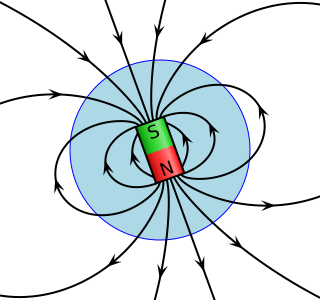 W
WThe ions and electrons of a plasma interacting with the Earth's magnetic field generally follow its magnetic field lines. These represent the force that a north magnetic pole would experience at any given point. Plasmas exhibit more complex second-order behaviors, studied as part of magnetohydrodynamics.
 W
WIn solar science, heliospheric pickup ions are created when neutral particles inside the heliosphere are ionized by either solar ultraviolet radiation, charge exchange with solar wind protons or electron impact ionization. Pickup ions are generally characterized by their single charge state, a typical velocity that ranges between 0 km/s and twice the solar wind velocity (~800 km/s), a composition that reflects their neutral seed population and their spatial distribution in the heliosphere. The neutral seed population of these ions can either be of interstellar origin or of lunar-, cometary, or inner-source origin. Just after the ionization, the singly charged ions are picked up by the magnetized solar wind plasma and develop strong anisotropic and toroidal velocity distribution functions, which gradually transform into a more isotropic state. After their creation, pickup ions move with the solar wind radially outwards from the Sun.
 W
WPlasma cosmology is a non-standard cosmology whose central postulate is that the dynamics of ionized gases and plasmas play important, if not dominant, roles in the physics of the universe beyond the Solar System. In contrast, the current observations and models of cosmologists and astrophysicists explain the formation, development, and evolution of astronomical bodies and large-scale structures in the universe as influenced by gravity and baryonic physics.
 W
WThe polar wind or plasma fountain is a permanent outflow of plasma from the polar regions of Earth's magnetosphere, caused by the interaction between the solar wind and the Earth's atmosphere. The solar wind ionizes gas molecules in the upper atmosphere to such high energy that some of them reach escape velocity and pour into space. A considerable percentage of these ions remain bound inside Earth's magnetic field, where they form part of the radiation belts.
 W
WIn the magnetosphere, the plasma sheet is a sheet-like region of denser hot plasma and lower magnetic field near the equatorial plane, between the magnetosphere's north and south lobes.
 W
WThe plasmasphere, or inner magnetosphere, is a region of the Earth's magnetosphere consisting of low-energy (cool) plasma. It is located above the ionosphere. The outer boundary of the plasmasphere is known as the plasmapause, which is defined by an order of magnitude drop in plasma density. In 1963 American scientist Don Carpenter and Soviet astronomer Konstantin Gringauz proved the plasmasphere and plasmapause's existence from the analysis of very low frequency (VLF) whistler wave data. Traditionally, the plasmasphere has been regarded as a well behaved cold plasma with particle motion dominated entirely by the geomagnetic field and, hence, co-rotating with the Earth.
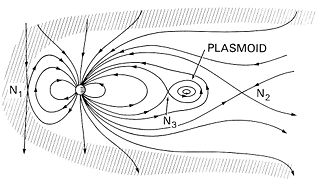 W
WA plasmoid is a coherent structure of plasma and magnetic fields. Plasmoids have been proposed to explain natural phenomena such as ball lightning, magnetic bubbles in the magnetosphere, and objects in cometary tails, in the solar wind, in the solar atmosphere, and in the heliospheric current sheet. Plasmoids produced in the laboratory include field-reversed configurations, spheromaks, and in dense plasma focuses.
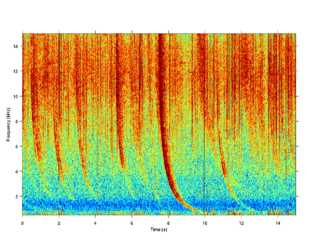 W
WA radio atmospheric signal or sferic is a broadband electromagnetic impulse that occurs as a result of natural atmospheric lightning discharges. Sferics may propagate from their lightning source without major attenuation in the Earth–ionosphere waveguide, and can be received thousands of kilometres from their source. On a time-domain plot, a sferic may appear as a single high-amplitude spike in the time-domain data. On a spectrogram, a sferic appears as a vertical stripe that may extend from a few kHz to several tens of kHz, depending on atmospheric conditions.
 W
WIn the field of Big Bang theory, and cosmology, reionization is the process that caused the matter in the universe to reionize after the lapse of the "dark ages".
 W
WSky brightness refers to the visual perception of the sky and how it scatters and diffuses light. The fact that the sky is not completely dark at night is easily visible. If light sources were removed from the night sky, only direct starlight would be visible.
 W
WA solar flare is a sudden flash of increased brightness on the Sun, usually observed near its surface and in close proximity to a sunspot group. Powerful flares are often, but not always, accompanied by a coronal mass ejection. Even the most powerful flares are barely detectable in the total solar irradiance.
 W
WThe solar transition region is a region of the Sun's atmosphere, between the chromosphere and corona. It is visible from space using telescopes that can sense ultraviolet. It is important because it is the site of several unrelated but important transitions in the physics of the solar atmosphere:Below, gravity tends to dominate the shape of most features, so that the Sun may often be described in terms of layers and horizontal features ; above, dynamic forces dominate the shape of most features, so that the transition region itself is not a well-defined layer at a particular altitude. Below, most of the helium is not fully ionized, so that it radiates energy very effectively; above, it becomes fully ionized. This has a profound effect on the equilibrium temperature. Below, the material is opaque to the particular colors associated with spectral lines, so that most spectral lines formed below the transition region are absorption lines in infrared, visible light, and near ultraviolet, while most lines formed at or above the transition region are emission lines in the far ultraviolet (FUV) and X-rays. This makes radiative transfer of energy within the transition region very complicated. Below, gas pressure and fluid dynamics usually dominate the motion and shape of structures; above, magnetic forces dominate the motion and shape of structures, giving rise to different simplifications of magnetohydrodynamics. The transition region itself is not well studied in part because of the computational cost, uniqueness, and complexity of Navier–Stokes combined with electrodynamics.
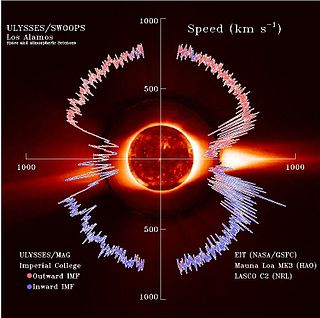 W
WThe solar wind is a stream of charged particles released from the upper atmosphere of the Sun, called the corona. This plasma mostly consists of electrons, protons and alpha particles with kinetic energy between 0.5 and 10 keV. The composition of the solar wind plasma also includes a mixture of materials found in the solar plasma: trace amounts of heavy ions and atomic nuclei C, N, O, Ne, Mg, Si, S, and Fe. There are also rarer traces of some other nuclei and isotopes such as P, Ti, Cr, Ni, Fe 54 and 56, and Ni 58,60,62. Embedded within the solar-wind plasma is the interplanetary magnetic field. The solar wind varies in density, temperature and speed over time and over solar latitude and longitude. Its particles can escape the Sun's gravity because of their high energy resulting from the high temperature of the corona, which in turn is a result of the coronal magnetic field.
 W
WThe South Atlantic Anomaly (SAA) is an area where Earth's inner Van Allen radiation belt comes closest to Earth's surface, dipping down to an altitude of 200 kilometres (120 mi). This leads to an increased flux of energetic particles in this region and exposes orbiting satellites to higher-than-usual levels of radiation.
 W
WSprites or red sprites are large-scale electric discharges that occur high above thunderstorm clouds, or cumulonimbus, giving rise to a quite varied range of visual shapes flickering in the night sky. They are usually triggered by the discharges of positive lightning between an underlying thundercloud and the ground.
 W
WA corona is an aura of plasma that surrounds the Sun and other stars. The Sun's corona extends millions of kilometres into outer space and is most easily seen during a total solar eclipse, but it is also observable with a coronagraph. Spectroscopy measurements indicate strong ionization in the corona and a plasma temperature in excess of 1000000 kelvin, much hotter than the surface of the Sun.
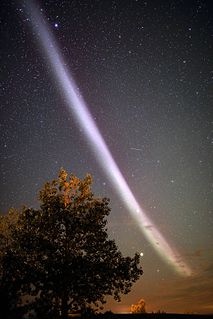 W
WSTEVE is an atmospheric optical phenomenon that appears as a purple and green light ribbon in the sky, named in late 2016 by aurora watchers from Alberta, Canada. According to analysis of satellite data from the European Space Agency's Swarm mission, STEVE is caused by a 25 km (16 mi) wide ribbon of hot plasma at an altitude of 450 km (280 mi), with a temperature of 3,000 °C and flowing at a speed of 6 km/s (3.7 mi/s). The phenomenon is not rare, but had not previously been investigated. In August 2018, researchers determined that the phenomenon's skyglow was not associated with particle precipitation and, as a result, could be generated in the ionosphere.
 W
WThe Sun is the star at the center of the Solar System. It is a nearly perfect sphere of hot plasma, heated to incandescence by nuclear fusion reactions in its core, radiating the energy mainly as visible light and infrared radiation. It is by far the most important source of energy for life on Earth. Its diameter is about 1.39 million kilometres, or 109 times that of Earth. Its mass is about 330,000 times that of Earth, and accounts for about 99.86% of the total mass of the Solar System. Roughly three quarters of the Sun's mass consists of hydrogen (~73%); the rest is mostly helium (~25%), with much smaller quantities of heavier elements, including oxygen, carbon, neon, and iron.
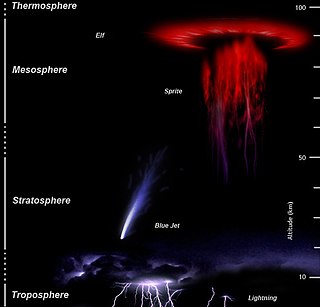 W
WUpper-atmospheric lightning or ionospheric lightning are terms sometimes used by researchers to refer to a family of short-lived electrical-breakdown phenomena that occur well above the altitudes of normal lightning and storm clouds. Upper-atmospheric lightning is believed to be electrically induced forms of luminous plasma. The preferred usage is transient luminous event (TLE), because the various types of electrical-discharge phenomena in the upper atmosphere lack several characteristics of the more familiar tropospheric lightning.
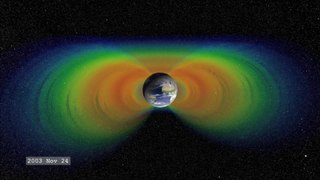 W
WA Van Allen radiation belt is a zone of energetic charged particles, most of which originate from the solar wind, that are captured by and held around a planet by that planet's magnetic field. Earth has two such belts, and sometimes others may be temporarily created. The belts are named after James Van Allen, who is credited with their discovery. Earth's two main belts extend from an altitude of about 640 to 58,000 km above the surface, in which region radiation levels vary. Most of the particles that form the belts are thought to come from solar wind and other particles by cosmic rays. By trapping the solar wind, the magnetic field deflects those energetic particles and protects the atmosphere from destruction.